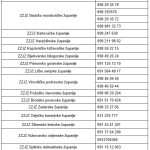As Novac/Marina Klepo writes on the 15th of April, 2020, after several weeks of strong pressure on the exchange rate owing to the ongoing coronavirus crisis, the Croatian kuna has finally started to strengthen against the euro over recent days. The reason for this, according to the Croatian National Bank (CNB/HNB), could be the fact that financial institutions settled their foreign currencies and adjusted the currency structure of their respective balance sheets, which were of course disturbed by the outbreak of the coronavirus pandemic.
In order to meet foreign exchange demand and preserve exchange rate stability, the CNB has held as many as five foreign exchange interventions in less than a month and has sold a total of 2.5 billion euros to the banks. The country’s international reserves have also fallen to around seventeen billion, the lowest level since the end of 2018.
Although the exchange rate has grown somewhat calmer, general uncertainty caused by this unprecedented situation in which we all find ourselves suggests that pressures on the exchange rate will continue in the coming period, raising the question of whether Croatia’s foreign reserves are ample enough for the central bank to maintain exchange the kuna’s rate stability.
If Governor Boris Vujcic is asked about the above, there is no need to fear, even in the event of a prolonged coronavirus crisis and the complete absence of foreign exchange inflows in the tourist season of about ten billion euros. Over recent weeks, Vujcic has repeatedly reiterated that Croatia’s international reserves “by all of the usual metrics” are more than sufficient to maintain the kuna’s exchange rate stability.
There are more indicators of the adequacy of foreign exchange reserves on top of that, too, which are most often measured against the value of imports. The central bank would have to provide enough foreign exchange to pay its import obligations within three to five months. IMF data shows that Croatia’s foreign exchange reserves cover the value of imports for 8.66 months. At the end of last year, according to Zrinka Zivkovic Matijevic, an RBA analyst, this coverage was a little longer, more specifically 9.3 months, “but the current levels indicate that they’re more than sufficient.” In addition, there is likely to be a significant decrease in imports during the coronavirus crisis, so the financing needs that come with that are likely to differ, too.
Since the outbreak of the 2008 financial crisis, the IMF has repeatedly stated that the Republic of Croatia’s foreign exchange reserves are lower than the “standard adequacy criteria” and that they’re not in line with the importance of the exchange rate for Croatia’s monetary policy. However, the CNB has denied such claims by the IMF, pointing out Croatia’s specifics, such as the foreign exchange assets of commercial banks, which are considerable. In addition, reserves have increased significantly over recent years, while the level of external debt, for example, has actually decreased. Six years ago, short-term debt coverage ranged from 85 to 90 percent.
Finally, the IMF believes that reserves can be deemed optimal if they range from 100 to 150 percent of the new “adequacy metric”, and in the case of Croatia – they are now at 1.37 percent.
Regardless of what the metric shows, numerous examples throughout history suggest that, regardless of their amount, foreign reserves are sometimes not sufficient to defend the value of a currency. In cases where confidence in the sustainability of the system has become disturbed and stronger foreign exchange purchases begin, it’s difficult to defend a domestic currency, but it isn’t impossible, as was shown with the case of Latvia back during the financial crisis.
In the event of heavy exchange rate pressures, the central bank may further reduce its kuna liquidity and thus its leeway to purchase foreign currency. However, in times of crisis, when liquidity becomes crucial, it is certainly not a desirable development.
To mitigate the effect of the kuna liquidity drag on foreign exchange intervention, the CNB purchased government securities back in March in the amount of 4.29 billion kuna. The excess liquidity of the banking system remained at a high of 32.2 billion kuna, so the interest rate at which the government was borrowing in the short term remained at a record low.
Whether high liquidity and thus low interest rates for the country, as well as for all other sectors, can be maintained will depend on just how strong the pressure on the exchange rate will become as the coronavirus crisis drags on and pitentially digs its heels in even more.
Make sure to follow our dedicated section for all you need to know about coronavirus in Croatia.










